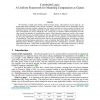Free Online Productivity Tools
i2Speak
i2Symbol
i2OCR
iTex2Img
iWeb2Print
iWeb2Shot
i2Type
iPdf2Split
iPdf2Merge
i2Bopomofo
i2Arabic
i2Style
i2Image
i2PDF
iLatex2Rtf
Sci2ools
COCO
2008
Springer
2008
Springer
Constraint Logic: A Uniform Framework for Modeling Computation as Games
We introduce a simple game family, called Constraint Logic, where players reverse edges in a directed graph while satisfying vertex in-flow constraints. This game family can be interpreted in many different game-theoretic settings, ranging from zero-player automata to a more economic setting of team multiplayer games with hidden information. Each setting gives rise to a model of computation that we show corresponds to a classic complexity class. In this way we obtain a uniform framework for modeling various complexities of computation as games. Most surprising among our results is that a game with three players and a bounded amount of state can simulate any (infinite) Turing computation, making the game undecidable. Our framework also provides a more graphical, less formulaic viewpoint of computation. This graph model has been shown to be particularly appropriate for reducing to many existing combinatorial games and puzzles--such as Sokoban, Rush Hour, River Crossing, TipOver, the War...
| Added | 18 Oct 2010 |
| Updated | 18 Oct 2010 |
| Type | Conference |
| Year | 2008 |
| Where | COCO |
| Authors | Erik D. Demaine, Robert A. Hearn |
Comments (0)

